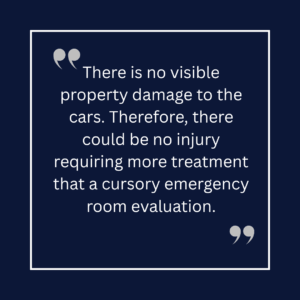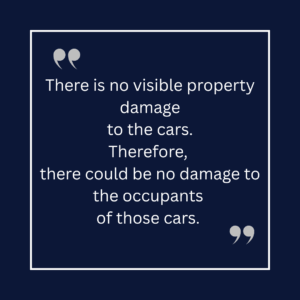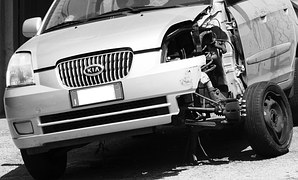My Car Does Not Have A Lot of Damage. Does That Mean I Was Not Hurt?
It is a classic, prototypical, archetypal, insurance defense argument, advanced in thousands of courtrooms, thousand of times a day. As Attorney Eric T. Kirk will tell you.

A more relaxed, refined version of the argument runs since there is no visible property damage to the cars. there could be no injury requiring more treatment that a cursory emergency room evaluation. Let’s look at how this general theme plays out in personal injury trials in Baltimore courtrooms.
Baltimore insurance companies hire skilled, dedicated, sophisticated, and above all effective personal injury lawyer to defend claims made. Here is some tactics you you may encounter,
This classic Baltimore insurance defense argument relies on a basic principle of physics: force is required to cause damage. The insurance lawyer invariably suggests its also “common sense.” The defense lawyer posits that if the collision forces were insufficient to bend steel, crack a plastic bumper cover, or even scratch paint, then they were logically insufficient to cause significant injury to the human body. The vehicle’s bumper and structure are presented as a “black box” recorder of the crash energy. If that box is undamaged, it’s argued that the energy transferred was minimal—well below any level required to harm an occupant protected within the car’s cabin
It’s a twist on the above, with he added appeal of “science”. This argument leverages federal safety standards as a baseline. The numbers have varied over time. Let’s say bumpers are engineered to withstand impacts up to a certain speed (historically 5 MPH, now often 2.5 MPH) with “no structural damage.” The defense argues that if a vehicle’s bumper is undamaged, the impact speed must have been below this low threshold. This speed is then equated to a trivial event, like a brisk walk or a slow jog. The assertion is that an impact the vehicle was specifically designed to handle without damage could not have generated the abnormal forces necessary to injure the occupants.
This argument contextualizes the collision’s G-forces by comparing them to routine activities. This is more than an argument, as evidence, or opinion is needed. Lets’ assume an insurance defense expert testifies that the forces in a low-speed, no-damage impact are often less than or equal to those from everyday actions like plopping into an office chair, a forceful sneeze, or stepping off a curb unexpectedly. By framing the accident’s forces as commonplace and benign, the argument suggests that if a person is not injured by these daily jolts, it is highly improbable they were injured by the demonstrably minor and comparable forces of the collision. Again, the skilled defense lawyers hired by the insurance company to defeat your case will emphasize the “common sense” appeal.
When there is little or no vehicle damage, scrutiny of the medical claims intensifies. This argument distinguishes between subjective complaints (e.g., “my neck hurts”) and objective medical findings (e.g., a fracture on an X-ray or disc herniation on an MRI). The defense argues that without clear, objective evidence of a traumatic injury, the occupant’s subjective symptoms are less credible. Obviously, the success of the argument hinges, to some extent, on the believability of the injured person. The undamaged car is presented as proof that a sufficient injury mechanism was absent, suggesting the reported pain may be pre-existing, exaggerated, or unrelated to the minor traffic incident.
An insurance company thinks so, and they will hire experts to say so in court. To be fair, this is not so much and argument, as part of the defenses’ case. This is a highly technical approach that uses defense experts, typically biomechanical engineers, to establish a scientific “threshold for injury.” The expert may studies and crash-test data to assert that a specific amount of force or change in velocity (Delta−V) is required to cause a soft tissue injury like whiplash. Based on the pristine condition of the car, the expert calculates that the forces of this specific impact fell safely below that scientifically established minimum. The conclusion presented is that, from a purely biomechanical standpoint, injury was mechanistically improbable or even impossible in this event.
The argument, in whatever incarnation, assumes, at its core, there is some scientific or medical correlation between property damage that can be perceived by the human eye, and depicted in a photograph, and injury to the human body. There is not one.

In fact, many contend the opposite is true. “Even though sustained in low-velocity, rear-end collisions, …. acceleration injury can produce forces significant enough to produce musculoligamentous tears with resultant hemorrhage and even disk disruption and avulsion fractures of the vertebral bodies.” 1

The insurance industry likes the idea that cars can be involved in collisions, and not appear to be, or indeed not be, seriously damaged. If the car is not damaged, there is less to repair, and less repair related expense. But there are other reasons. An illustration is found in the history of federal laws and regulations governing bumpers. Bumpers are designed so that there is no damage to the vehicle at certain low-speed collisions. The federal rule provides that “the purpose of this standard is to reduce physical damage to the front and rear ends of a passenger motor vehicle from low-speed collisions.49 CFR § 581.22 “Before 1982, federal safety standards required cars to have bumpers that could withstand a 5-m.p.h. collision without serious damage to the car’s frame or body and only inconsequential damage to the bumper.” 3 The Reagan administration lowered the ‘no damage’ standard. Modern bumpers are designed to specifically show no damage to the car at collisions of less than 2.5 mph, but the bumper can show damage. Not surprisingly, the insurance industry lobbied heavily against the change. “The insurance institute and insurance companies have been lobbying to maintain the existing [ 5 mph] standard.” 4 Why? Although the no “property damage/no injury” argument was likely not as widespread in the early 80’s, of course, the insurance industry liked the idea that cars can be involved in higher velocity impacts without visible damage. It allows their adjusters and attorneys to minimize the accident, minimize the damage, and minimize the effects on the occupants.
Insurance companies deny thousands of claims daily. They hire sophisticated lawyers who make persuasive arguments in court. Those who have no been through the process are often amazed and sometimes overwhelmed, by the level of resistance to the payment of claims. I extend a complimentary case analysis and opinion about their legal case to those that consult with me. Please call me today to arrange a meeting
FN 1 Dunn EJ, Blazer S. Soft tissue injuries of the lower cervical spine. Instructional course lectures, Am Academy of Ortho Surgeons, 1987; 36:499-512.
FN 2 https://www.law.cornell.edu/cfr/text/49/581.2
FN 3 https://www.chicagotribune.com/news/ct-xpm-2006-06-04-0606030267-story/
FN 4 https://www.nytimes.com/1981/11/13/us/insurers-support-bumper-standards/.
Auto accident and personal injury FAQ section



